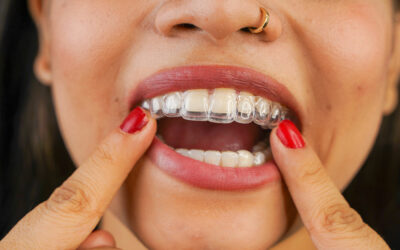According to the Australian Dental Association, the research found that around 75% of Australian adults rarely or never floss or clean their teeth! While your mouth may *feel* clean after brushing, there are many crevices and areas a toothbrush cannot reach. This leaves certain areas prone to plaque buildup and decay.
In this blog post, we’ll cover the importance of flossing and many of the commonly asked questions about flossing, including how often to floss, what type of floss to use, and when your child should start flossing.
The Importance of Flossing
Flossing — also known as interdental cleaning — refers to cleaning between the teeth.
While brushing twice a day and using mouthwash is a wonderful start to a good oral hygiene routine, if you aren’t flossing, your oral health is at risk.
It is estimated that almost half of the surface area of the teeth is between the teeth, not just the front and back. This means brushing only cleans about half your mouth, leaving the other half susceptible to the build-up of dental plaque.
Dental plaque, a sticky film that can lead to gum disease, can build up if the areas between the teeth and near the gumline are not properly cleaned. Floss gets into these tiny crevices and awkward spaces to ensure any stuck food or debris is removed.
Daily flossing helps prevent:
- Plaque build-up
- Tooth decay
- Halitosis (bad breath)
- Gum disease
How Often Should You Floss Your Teeth?
The Australian Dental Association recommends that adults and children floss at least once a day as part of a good oral health routine.
If you have gum disease, your dentist may recommend that you floss after every meal.
Why Do My Gums Bleed When I Floss?
When you clean between your teeth, you may notice a small amount of bleeding. Bleeding gums are more common in individuals who do not floss regularly.
When plaque builds up in the crevices between teeth and near the gum line, the delicate tissue can become inflamed, leading to bleeding during flossing.
If you notice bleeding during flossing, it is important to stick to a daily flossing routine. If your gums still bleed, even after following a daily flossing routine, speak to your dentist to rule out any underlying issues.
The bottom line? Healthy gums do not bleed.
How Do I Floss Correctly?
For instructions on how to floss correctly, you can check the Australian Dental Association’s page on how to floss or ask your dentist to demonstrate the proper technique at your next checkup.
Here are the general steps to flossing correctly:
- Grip a piece of floss, about 45 cm long, between your thumb and index finger on each hand
- Gently slide the floss down between two teeth, being careful not to press too hard downwards or upwards
- Use side to side and up and down motions to gently slide the floss between the teeth
- Take care to clean along the gum line of each tooth as well, rubbing gently as you gently slide the floss slightly below the loose gum line
- Make sure to clean in between all teeth and behind each of your molars (flossing should take you at least two minutes to complete)
Should I Floss Before Or After Brushing My Teeth?
Whether you floss before or after you brush your teeth is not important. As long as you floss at least once a day, there is no ‘correct’ or ‘incorrect’ time to do it. The best time to floss is the time that works best with your daily routine.
When Should My Child Start Flossing?
As soon as your child has two teeth next to each other, typically around age two, you should help them start flossing. It is important to help your child develop daily oral hygiene habits.
You should assist your child with flossing until they can do it on their own, usually between the ages of 8 and 10. Still, it is important to continue supervising your child to ensure he or she is flossing properly.
What Are the Common Types of Dental Floss?
People are often surprised by the number of dental floss options available. From standard floss to high-tech flossing tools, it is possible to find an option that works best for you.
There is no single type of floss that will work best and you may want to try several options to find which type you prefer. If you need help deciding on the right type of floss for you, ask your dentist for a recommendation.
Below you’ll find brief explanations of the different types of dental flosses.
Waxed and Unwaxed Floss
Nylon floss is available in both waxed and unwaxed versions. Unwaxed floss consists of almost three dozen strands of nylon twisted together. As the name implies, waxed floss is covered with a thin wax coating.
Unwaxed and waxed floss both have their pros and cons. Unwaxed floss is excellent for fitting into tight spaces, but if the teeth are too close, unwaxed floss can get stuck or frayed.
Some individuals prefer waxed floss as it tends to glide easier and smoother through the spaces between teeth. However, the wax coating does make it slightly thicker, meaning extremely narrow spaces or overcrowded teeth will be more difficult to reach.
- Dental Tape — Dental tape is broader and thicker than traditional dental floss, making it ideal for individuals with wider spaces between their teeth. Its thicker structure reduces the chances of it shredding or breaking. It is available in unwaxed or waxed options.
- Super Floss — Super floss is fabricated from a yard-type material. Super floss is ideal for cleaning around dental bridges or braces. With stiffer sections on each end, super floss is more durable and effective for getting into complex or tight spaces.
- PTFE Floss — Polytetrafluoroethylene (Teflon) floss, a less common type of floss, is made from Gore-Tex fabric. This high-tech fabric helps prevent shedding and ensures the floss can easily glide through the teeth.
- Biodegradable and Natural Floss — If throwing floss away is a concern for you, you can find biodegradable floss options made from plant-derived, vegan materials.
- Flossing Aids — Flossing aids such as dental floss picks, electric dental flossers, and water flossers are potential options for individuals who struggle with dexterity, young children, people with braces, or people who simply don’t like using standard floss.
Can I Use a Toothpick to Clean Between My Teeth?
No, a toothpick should not be used to clean between teeth. Toothpicks are not a safe substitute for flossing and should be avoided.
Toothpick use can cause gum damage and wear away teeth when used over the long term. Toothpicks can also break, splinter, and leave pieces stuck between the teeth.
It’s Never Too Late to Make Flossing a Part of Your Daily Routine
Daily flossing is a crucial component of a good oral hygiene routine. Flossing reaches the spaces between the teeth and near the gumline that often get missed by brushing.
Including flossing as part of your daily oral hygiene routine significantly reduces your chance of plaque build-up, cavities, bad breath, decay, and other oral health complications.
If you need help determining the best dental floss for you, want to make sure you are flossing right, or want to schedule an appointment to speak to a dentist about bleeding gums, please do not hesitate to contact our team.









